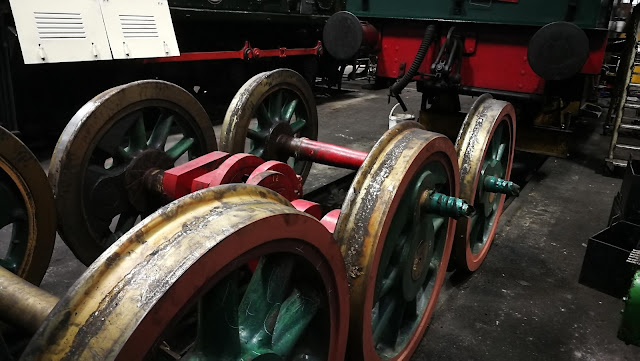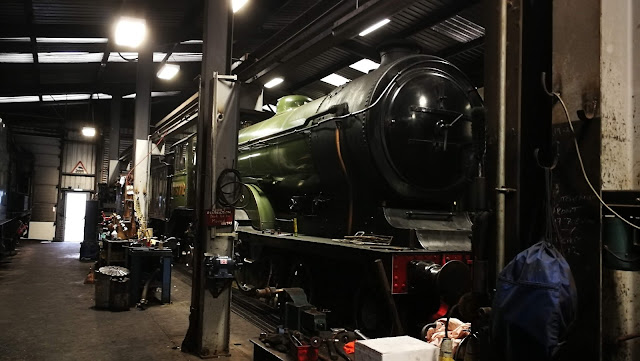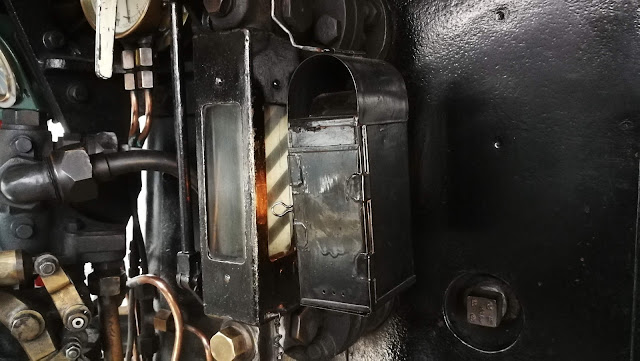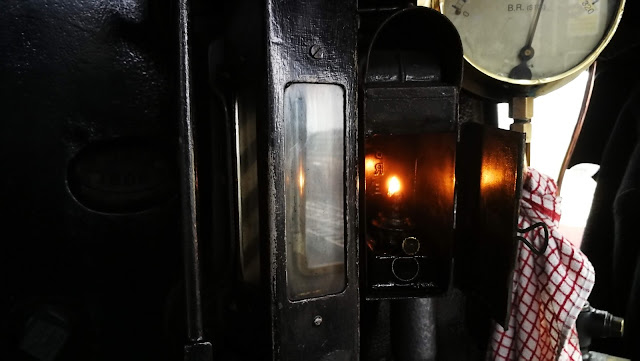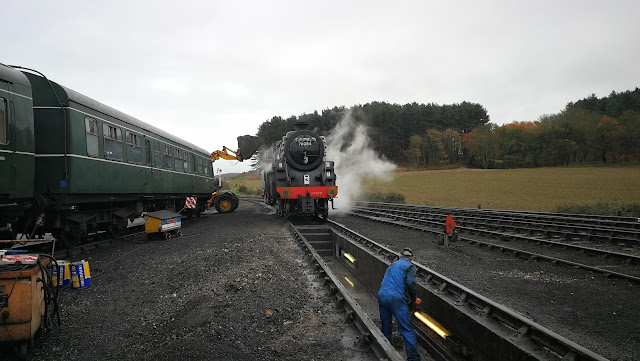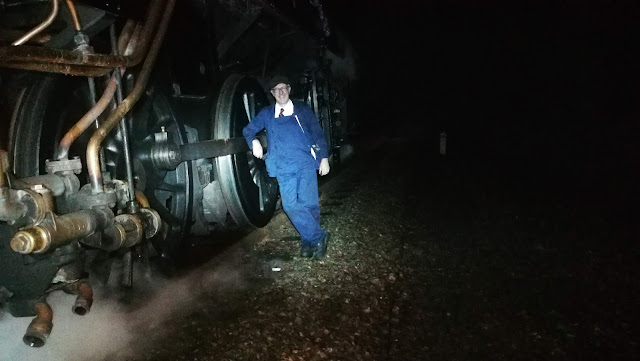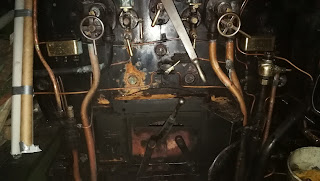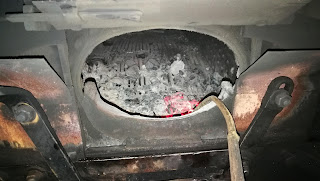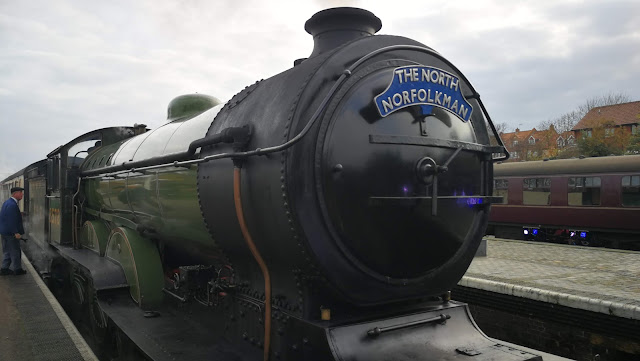Turn 13 was another new experience - a turn mostly conducted at night. This year for the first time the railway is running its Norfolk Lights Express, a train of lights which runs up to Holt & back, non-stop through a Norfolk countryside enhanced with Christmas lights and illuminated woodland scenes.
The service was to start on the 20th November and run until Christmas - it has been so popular, that the railway has timetabled an extra week in January.
The train includes the buffet car, three second class open coaches, a brake coach and the CCT. The CCT is a van originally designed to carry cars (it has opening doors at each end with a drop down ramp) which today holds two 30 kVA generators for the lights on the train. The train has been decorated with miles of coloured light ropes attached to nets draped over the vehicles, and with coloured lights slung under the chassis to illuminate the landscape.
The designated loco is the BR Standard 4MT, which is also bedecked with light ropes, powered from the train.
Since the service starts at 16:30, we are signing on at 11:00 - not much point having a train of lights in daylight. Cleaner Paul already has the fire well going when I arrive, so there is no hurry. He has been on shed since 10 and it's raining which means there will be little cleaning today.
In the shed, Wissington's wheels have arrived complete with new tyres and a new axle:
And the 7F's pony truck is back on!
I busy myself with the cab roof and the buffer beams, and fetch the lamps - these are Fireman's jobs, and as I'm Third Man today I will do them. I check that our flags are on board and that we have spare gauge glasses and seals. As it happens, one of the gauge glasses is weeping - it's a simple job to tighten the seals with your hands only.
Paul has topped the tender tank up, and I put the yard hose away. It's an easy morning so far.
We ash out, and all of a sudden it gets less easy. Whilst the 4MT has a hopper ash pan, which allows you to drop the ash straight in the pit without raking it out, it has spark screens which are very awkward to fit and an arch in the ashpan over the rear axle. What this means is that you are poking the pit hose awkwardly into the pan to try and clean it out, and then you have to dash under the dripping pan to the rear of the loco to struggle with the screen at the back. This is the third time I have done this and it doesn't get any easier. At least Paul clears out the pit while I attempt to dry myself.
Then it was back down to Weybourne; we stopped at platform 2 to let me off to operate the ground frame to let the engine into the yard. I used a white light signal, waving the light from side to side, to signal the driver to come forward into the yard. I walked over to the pit which would be their next stop, to switch on the yard and pit lights so we could see what we were doing.
While Driver Fozz made his inspection, I got the pit hose ready to wash out the ash pan. We pulled off the front spark screen and washed the pan out; Fireman Phil cleaned the fire with the fire irons and then we dropped the ash into the pit.
And that was it, my first night turn. All that was left was to empty the pit, get changed and go home.
The service was to start on the 20th November and run until Christmas - it has been so popular, that the railway has timetabled an extra week in January.
The train includes the buffet car, three second class open coaches, a brake coach and the CCT. The CCT is a van originally designed to carry cars (it has opening doors at each end with a drop down ramp) which today holds two 30 kVA generators for the lights on the train. The train has been decorated with miles of coloured light ropes attached to nets draped over the vehicles, and with coloured lights slung under the chassis to illuminate the landscape.
The designated loco is the BR Standard 4MT, which is also bedecked with light ropes, powered from the train.
Since the service starts at 16:30, we are signing on at 11:00 - not much point having a train of lights in daylight. Cleaner Paul already has the fire well going when I arrive, so there is no hurry. He has been on shed since 10 and it's raining which means there will be little cleaning today.
In the shed, Wissington's wheels have arrived complete with new tyres and a new axle:
The B12 is in for some winter maintenance:
And the 7F's pony truck is back on!
I busy myself with the cab roof and the buffer beams, and fetch the lamps - these are Fireman's jobs, and as I'm Third Man today I will do them. I check that our flags are on board and that we have spare gauge glasses and seals. As it happens, one of the gauge glasses is weeping - it's a simple job to tighten the seals with your hands only.
Paul has topped the tender tank up, and I put the yard hose away. It's an easy morning so far.
We ash out, and all of a sudden it gets less easy. Whilst the 4MT has a hopper ash pan, which allows you to drop the ash straight in the pit without raking it out, it has spark screens which are very awkward to fit and an arch in the ashpan over the rear axle. What this means is that you are poking the pit hose awkwardly into the pan to try and clean it out, and then you have to dash under the dripping pan to the rear of the loco to struggle with the screen at the back. This is the third time I have done this and it doesn't get any easier. At least Paul clears out the pit while I attempt to dry myself.
We went off shed at 14:50 or thereabouts, Paul handled the ground frame as there was no-one in the signal box. We would be operating Single Train on Line that day, and once Paul had helped us onto the running line we would carry the Long Section staff down to the signalman at Sheringham.
We had 90 minutes to wait, warming the train and learning about the electrical connections for the lights - and the two way radio we were to use to talk to the RO during the trip, to slow us down or speed us up. We decided that I would handle the radio and call out the signals - we weren't at all sure what demands the slow trip would have on the fire - whilst Driver Fozz had done two NLE trains, Fireman Phil and I had not done any so it was a bit of a new experience for us.
While we were at Sheringham, Phil taught me that the optimal way to fire was to keep the fire thin and make sure that your were aware of it's condition at all times. That way you can react and create heat when you need it but you will always have the option of allowing it to cool to prevent blowing off. However, he also said that when you don't have the energy in the fire a boilerful of steam will deplete very quickly when there is a demand. We sat at Sheringham warming the train and eating our lunch for a while. Just before 4 o'clock, with 35 minutes to go, we started to build the fire whilst trying to avoid creating too much smoke.
The run up to Holt was uneventful, with the trains lights coming on as programmed by the Mac living in the BSK. The night time aspect of the trip didn't present the problems I had imagined - a green light is just as visible as a green flag, but you have to remember to acknowledge the guard's signal with a white light held steady.
Returning to Sheringham the wind had picked up to a 25 mph Northerly which was whipping through the cab - I felt my cap lift and before I realised what was going on it was gone, off onto the golf course, the road, or the allotments somewhere. I made a note of where we were in case I could find it on a dog walk or something.
When we reached the station we had about 40 minutes to run around and take on water before the next train. Today I was the man on the tender, grappling with a torch (in my teeth) and the giant water hose from the crane at the end of platform 2. The hose is a bit tired and leaky and coupled with my inexperience I finished the job with leather gloves wet through and one leg soaked. Back on the footplate on the way up to Holt, nothing stayed wet very long.
We left the last train back at Sheringham just before 8, and ran around stopping once again to refill the tender. It's much, much faster to fill the tender from the water crane than using the yard hose, so tomorrow's crew would have less to do. While Fireman Phil was building the fire for the run, a mystery object appeared in the shovel - my cap! It must have blown into the tender, for it had come down on the coal.
Next job was to run up the line again, light engine this time, stopping to switch off all the generators. Without the lights from the train the run up was pitch dark and we were able to go at normal line speed of 25 mph. We took a couple of pictures on the way back:
Then it was back down to Weybourne; we stopped at platform 2 to let me off to operate the ground frame to let the engine into the yard. I used a white light signal, waving the light from side to side, to signal the driver to come forward into the yard. I walked over to the pit which would be their next stop, to switch on the yard and pit lights so we could see what we were doing.
While Driver Fozz made his inspection, I got the pit hose ready to wash out the ash pan. We pulled off the front spark screen and washed the pan out; Fireman Phil cleaned the fire with the fire irons and then we dropped the ash into the pit.
And that was it, my first night turn. All that was left was to empty the pit, get changed and go home.



